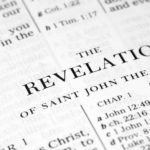Why should you think Revelation is as much about the past as it is about the future? Because Revelation isn’t always about the future. Smack dab in the middle of the book we have a symbolic depiction of Jesus’ birth and resurrection. Revelation 12
“1 A great sign appeared in heaven: a woman clothed with the sun, with the moon under her feet and a crown of twelve stars on her head. 2 She was pregnant and cried out in pain as she was about to give birth. 3 Then another sign appeared in heaven: an enormous red dragon with seven heads and ten horns and seven crowns on its heads. 4 Its tail swept a third of the stars out of the sky and flung them to the earth. The dragon stood in front of the woman who was about to give birth, so that it might devour her child the moment he was born. 5 She gave birth to a son, a male child, who “will rule all the nations with an iron scepter.” And her child was snatched up to God and to his throne. 6 The woman fled into the wilderness to a place prepared for her by God, where she might be taken care of for 1,260 days.”
No one disputes that this is about Jesus’ birth and resurrection. And for John, the author of Revelation, this was a past event. And yet John doesn’t skip a beat in describing something past right in the middle of his book. So if it happens here, shouldn’t we ask if it happens elsewhere? I think it’s pretty clear that it does. In Revelation 4-5, John describes a vision of the throne of God and a scroll that God holds in his hand. A search is made of heaven and earth for someone worthy to open the scroll. Chapter 5:
Then I saw in the right hand of him who sat on the throne a scroll with writing on both sides and sealed with seven seals. 2 And I saw a mighty angel proclaiming in a loud voice, “Who is worthy to break the seals and open the scroll?” 3 But no one in heaven or on earth or under the earth could open the scroll or even look inside it. 4 I wept and wept because no one was found who was worthy to open the scroll or look inside. 5 Then one of the elders said to me, “Do not weep! See, the Lion of the tribe of Judah, the Root of David, has triumphed. He is able to open the scroll and its seven seals.” 6 Then I saw a Lamb, looking as if it had been slain, standing at the center of the throne, encircled by the four living creatures and the elders. The Lamb had seven horns and seven eyes, which are the seven spirits of God sent out into all the earth. 7 He went and took the scroll from the right hand of him who sat on the throne.
At first no one was found worthy to open the scroll and John weeps for the state of humanity. But then something changes. Jesus, the lion and lamb, is found worthy because of his triumph. And he takes the scroll in his hand. For John, when does this scene happen? It’s clearly in the past. It’s no longer the case that no one is worthy to take the scroll. Jesus has triumphed. So when does/did Jesus take scroll and begin to break its seals? The answer is as soon as he triumphed. He began breaking the seals in the first century and has continued to breaking them to this day.
6 times, John describes the same time period which is from Jesus to the end of time. And yet each time he uses different metaphors to do it. And each time, he begins and ends his description in worship
















